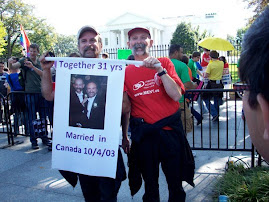Counting what matters with gay marriage
Same-sex couples denied access to marriage: Zero
By Kevin Bourassa and Joe Varnell
"Same-sex unions growing at five times that rate of heterosexual ones”, said one headline from the Canadian Press (Sept 12, 2007).
“Same-sex couples increase by 30 percent”, said another headline.
Various media have been full of declarations about the state of family life in Canada ever since Sept. 12 when Statistics Canada released new census data collected in 2006: Family Portrait: Continuity and Change in Canadian Families and Households in 2006.
The report clearly shows the impacts that resulted from the loss of earning power in average families. Fifty years ago, a family could live on one income. Today average families struggle to get by on two salaries. We encourage you to read the report in detail and make your own conclusions.
This report is also getting a lot of attention because, as the report says, "For the first time, the census counted same-sex married couples, reflecting the legalization of same-sex marriages for all of Canada ..."
From the perspective of same-sex marriage, we are only tracking one statistic: The number of same-sex couples who are denied access to marriage in a Canadian province or territory. That number is zero and we're counting on that remaining so from now on.
--------------------------------------------------------------------------------
Excerpted from "Statistics Canada: Family Portrait ... 2006"
The 2006 Census enumerated 45,300 same-sex couples. Of these, about 7,500 or 16.5% were married couples.
Canada became the third country in the world to legalize same-sex marriage, after the Netherlands (2000) and Belgium (2003). Spain (2005) and South Africa (2006) became the fourth and fifth countries, respectively, where same-sex marriage can legally occur. Other countries have various other laws and policies. For example, Israel recognizes same-sex marriages performed in other countries. In the United States, Massachusetts legalized same-sex marriage in 2004, the only state to have done so.
The counts of same-sex couples are not large, yet growth was still quite dramatic during the intercensal period. The number of same-sex couples surged 32.6% between 2001 and 2006, five times the pace of opposite-sex couples (+5.9%).
In 2006, same-sex couples represented 0.6% of all couples in Canada. This is similar to 2006 data from New Zealand (0.7%) and Australia (0.6%) and higher than Ireland (0.2%). While not directly comparable, in the United States, same-sex couples comprised 0.7% of households in 2005.
Over half (53.7%) of same-sex married spouses were men in 2006, compared with 46.3% who were women. Proportions were similar for same-sex common-law partners in both 2006 and 2001. Male couples were also more predominant in Australia and Ireland, while female couples predominated in New Zealand.
Children were present in the home for less than one-tenth of persons in same-sex couples. About 9.0% of individuals in same-sex couples had children in 2006. This was more common for women in same-sex couples (16.3%) than for men (2.9%).
Same-sex married spouses were more likely to have children present in the home compared to same-sex common-law partners, and this was especially the case for women. Among same-sex married spouses, 16.2% had children, as did 7.5% of partners in same-sex common-law couples. Again, women in same-sex married couples were more likely to have children (24.5%) than women in same-sex common-law unions (14.6%). Similarly, 9.0% of men in same-sex married couples had children, compared with only 1.7% of men in same-sex common-law couples.
In general, people in same-sex couples were younger than their counterparts in opposite-sex couples. For example, 24.5% of persons in same-sex couples were aged 34 and under, while only 3.8% were seniors aged 65 or older. In contrast, 18.1% of people in opposite-sex couples were aged 34 and under, while 16.0% were seniors.
Ontario became the first province to legalize same-sex marriage in June 2003. Over one-fifth (21.5%) of same-sex couples in this province were married, well above the national average of 16.5%.The 2006 Census counted 17,500 same-sex couples in Ontario, representing 0.6% of all couples in the province, on par with the national average. Of all same-sex couples in Canada, 38.6% lived in Ontario.
The 2006 Census enumerated 7,000 same-sex couples in British Columbia, accounting for 0.7% of all couples in the province, just above the national average of 0.6%. British Columbia was the second province to legalize same-sex marriage in July 2003. Of all same-sex couples in the province, 1,400, or 19.5%, were married.
Quebec was the third province to legalize same-sex marriage in March 2004. Of the 13,700 same-sex couples in Quebec, 1,300, or 9.2%, were married couples. This proportion is below the national average of 16.5% which may reflect the greater popularity of common-law unions in general for all couples in the province.
Read Statistic Canada's Family Portrait: Continuity and Change in Canadian Families and Households in 2006, 2006 Census
Tuesday, October 2, 2007
Counting what matters wtih gay marriage
Subscribe to:
Post Comments (Atom)


No comments:
Post a Comment